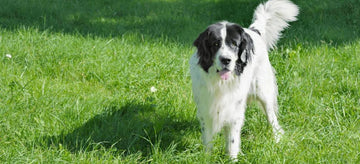The Tale of Tails: Why Do Dogs Have Tails and What Are Their Functions?
by Jamie Tedder on Jul 20, 2023

Greetings to all dog enthusiasts and seekers of knowledge! Our fascination with dogs goes far beyond their appealing character and unwavering loyalty. We marvel at their diverse manifestations, the wide range of shapes and sizes, and the distinct characteristics that separate one breed from another. Among these features, the tail often sparks particular curiosity and interest. Many of us have caught ourselves pondering over the purpose of a dog's tail. If you belong to that group, prepare yourself for an enlightening exploration into the intriguing realm of canine anatomy, where we'll shed light on the pressing question, "Why do dogs have tails, and what are their functions?" So, fasten your metaphorical seatbelts and brace yourself for an engaging and informative journey into the world of our beloved four-legged companions.
Diving Deeper into the Importance of a Dog's Tail
At first glance, a dog's tail might seem like a fluffy appendage that accentuates its overall cuteness. But as we delve deeper into the anatomy and functionality of this appendage, we encounter a reality that is as compelling as it is educational. A dog's tail is more than just a cute accessory; it plays a pivotal role in their life, bearing multiple responsibilities. From serving as a crucial navigational tool while the dog swims to maintaining balance during high-impact physical activities and even acting as an indispensable channel for communication, a dog's tail is much like a Swiss army knife - versatile, multi-purpose, and critical. Now that we have established the importance of a seat let's dissect these intriguing functions one by one to comprehend how indispensable a tail truly is for our four-legged friends.
Tails as Navigational Aids: Guiding Through the Waters
There's something innately joyous and heartwarming about watching dogs frolic in the water, their energy and enthusiasm infectious. Whether making a splash at the beach, wading through a lake, or paddling their way in a home swimming pool, the spectacle never fails to bring a smile to our faces. If you've ever observed a dog swim, you may have noticed their uncanny ability to navigate through water with remarkable ease. Their firm, muscular limbs contribute to their swimming abilities, but another critical player often goes unnoticed - the tail. Acting much like a rudder that guides a ship, a dog's tail is significant in steering and maintaining balance while swimming.
Consider water-loving breeds such as Labrador Retrievers, Portuguese Water Dogs, or Newfoundlands. These dogs are renowned for their affinity for water and exceptional swimming skills, a considerable part of which can be attributed to their robust, muscular tails. As a rudder, these tails facilitate steering, help make swift turns, and maintain balance while swimming. It's fascinating to observe that a seat does much more than sway in the water; it propels the dog through water, moving side-to-side, not unlike a boat's propeller. So, the next time you witness a dog navigating through water, remember to give credit to the often-overlooked expert navigator - their tail!
Tails as Balancing Instruments: Masters of Graceful Movement
The agility of dogs in motion is truly a sight to behold. Whether running at top speed, making sharp turns, or leaping in mid-air to fetch a ball, the grace and balance they exhibit in their movements are awe-inspiring. As we delve deeper into their anatomical marvels, we find that the tail is one of the key elements contributing to this agility and balance. Functioning as a counterbalance, the tail helps dogs maintain stability during high-speed chases, sharp turns, and high leaps.
Take, for instance, the Greyhound - a breed admired worldwide for its lightning-fast speed. When Greyhounds sprint, their tails are in constant motion, adjusting to maintain balance and ensure swift, controlled turns without losing momentum or direction. Similar observations can be made with agile breeds like Border Collies and Australian Shepherds, which often use their tails to balance themselves when they make sharp turns, leap over obstacles, or navigate agility courses or while herding.
Tails as Communication Channels: Speaking Without Words
As we explore the fascinating world of dogs, we come across a dimension of a dog's tail that's as captivating as it is essential - its role in communication. Dogs, unlike humans, cannot express themselves with words. They rely on a comprehensive and complex communication system that heavily involves body language, and the tail plays a critical part in this non-verbal communication. The movement and position of the tail are nothing less than a language in themselves, allowing dogs to express a wide range of emotions.
It's universally understood that a wagging tail usually signifies a happy dog. However, the 'tail talk' nuances go far beyond this basic understanding. The speed of the wagging and its direction can provide insights into the dog's emotional state. A slow, almost hesitant wag could indicate caution or uncertainty, while a quick, vigorous wag is often associated with excitement or happiness. The direction of the wagging also holds significance. Several studies suggest that wags leaning towards the right side are usually associated with positive emotions, whereas left-leaning wags could indicate negative emotions.
Alongside wagging, the position of a dog's tail holds a wealth of information about its emotional state. A tail held high often indicates confidence, alertness, or excitement. On the other hand, a tail kept low or tucked between the legs is usually a sign of fear, submission, or discomfort.
Understanding this nuanced language of tails can significantly enhance our interactions with our canine companions. For example, when you are training your dog to use the Gotta Go Grass dog grass pad, the position and movement of their tail could offer valuable insights into their comfort level and feelings towards the training process. A tail held high and wagging towards the right can indicate that the dog is comfortable and happy with the training. These small observations and understanding can strengthen bonds between humans and dogs, fostering better companionship.

The Grand Conclusion: Celebrating the Multi-functional Aspect of Tails
In the grand scheme of canine existence, the tale of tails is indeed one of multifunctionality, importance, and intrigue. A dog's tail is not merely an adornment; it serves critical functions in a dog's life, acting as a rudder in the water, aiding in maintaining balance during movement, and communicating a spectrum of emotions. These indispensable roles are integral to the charm and fascination we associate with our beloved canine friends.
So, the next time you witness a dog wagging its tail or see your furry friend step onto the Gotta Go Grass, take a moment to appreciate the tail and its multiple functions. Maybe the tail is sharing a captivating story of its own! Remember, every wag tells a tale, and every tail has a tale to tell. Keep observing, keep learning, and continue fostering the incredible bond humans share with their canine friends!




